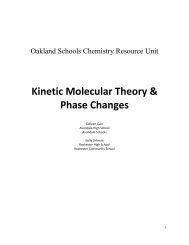Electrons and Quantum Mechanics - Oakland Schools
Electrons and Quantum Mechanics - Oakland Schools
Electrons and Quantum Mechanics - Oakland Schools
Create successful ePaper yourself
Turn your PDF publications into a flip-book with our unique Google optimized e-Paper software.
COMMON ELECTRON CONFIGURATION SCHEME B<br />
Any of these schemes, if used correctly, will give you the same thing, the sequence of<br />
the addition of the electrons to the shells. This pattern is correct for all of the elements<br />
that are not Transitional Elements or Lanthanides or Actinides. Of the Transitional<br />
Elements <strong>and</strong> Lanthanides <strong>and</strong> Actinides about one third of the elements do not follow<br />
the pattern. The Periodic Chart below is arranged sideways to show the electron<br />
configuration by shell. As you work with the schemes for finding the electron<br />
configuration of elements, you can check to see if your answer is correct by adding the<br />
electrons in each shell (downwards in the first scheme) <strong>and</strong> comparing with the<br />
Sideways Periodic Chart. The elements that do not fit the pattern have an asterisk by<br />
them. In the Transition Elements that do not follow the scheme, only the s subshell of<br />
the outer shell <strong>and</strong> the d subshell of the next to last shell have some trading between<br />
them. In the Lanthanide <strong>and</strong> Actinide series any trading of electrons are between the d<br />
subshell of the next to last shell <strong>and</strong> the f subshell of the second to last shell, the one<br />
filling as the elements progress up that series.<br />
16
















